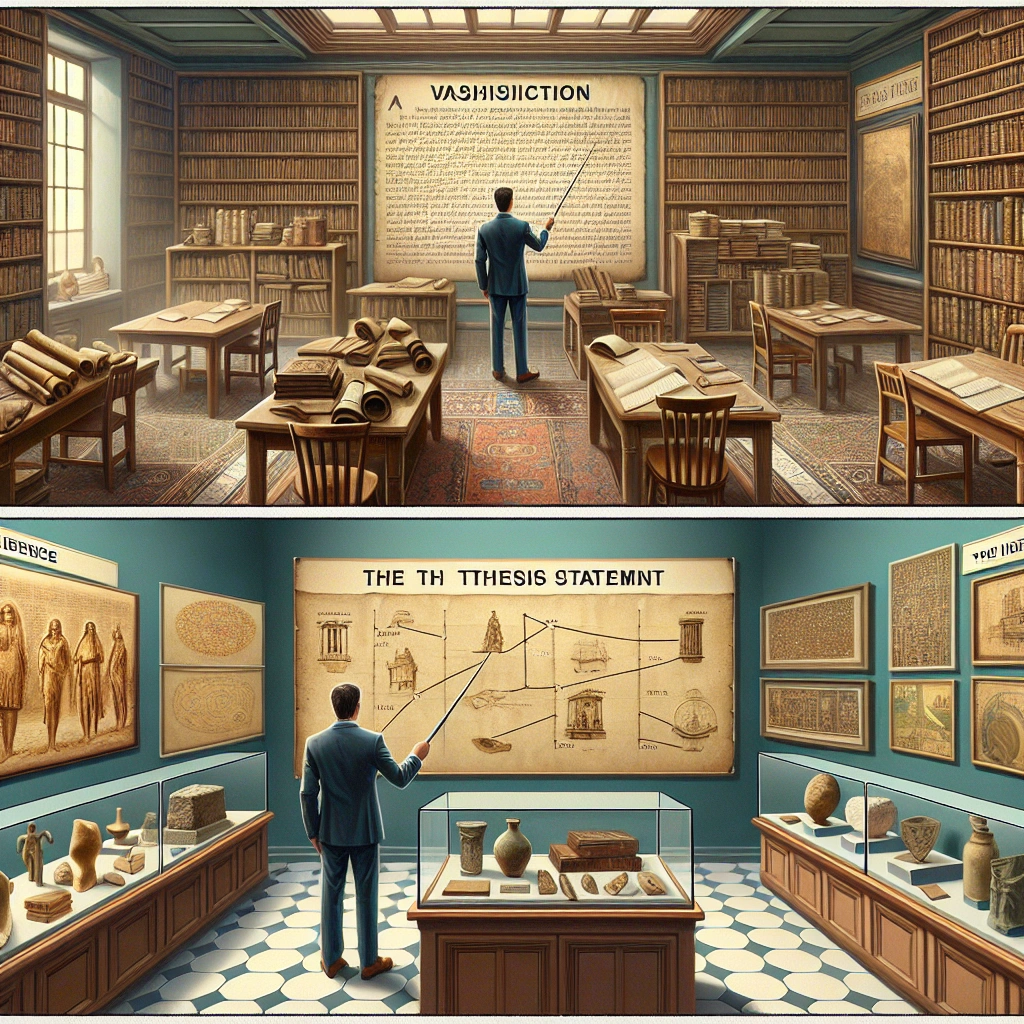What Are Some Examples Of Historical Facts Used To Support A Thesis Statement – Top Examples


Historical facts are crucial in supporting a thesis statement because they provide evidence and credibility to the argument being made. Without historical facts, a thesis statement would be weak and unsupported.
In the article, we will discuss examples of historical facts that are commonly used to support a thesis statement, such as primary source documents, statistical data, eyewitness accounts, and scholarly research. These examples help to validate the argument and make the thesis statement more persuasive and convincing to the reader.
By understanding the importance of historical facts and examining specific examples, writers can strengthen their thesis statements and produce more compelling and well-supported historical arguments.
Importance of Historical Facts in Thesis Statements
Understanding the role of historical facts in providing evidence for a thesis statement
Historical facts play a crucial role in providing evidential support for a thesis statement. They serve as the backbone of a thesis, offering tangible proof and credibility to the argument being presented.
When crafting a thesis, historical facts act as a solid foundation, allowing the author to establish a compelling narrative backed by concrete evidence from the past. Thus, historical facts not only lend credibility but also authenticity to the thesis statement, consolidating its significance in the academic or historical context.
Examples of how historical facts add credibility to a thesis statement
For example, in a historical thesis discussing the impact of the Industrial Revolution on society, specific historical facts such as the introduction of mechanized manufacturing processes, the rise of urbanization, and the changing dynamics of labor relations can be cited. These facts bolster the thesis, providing a clear link between the stated argument and the historical evidence.
Another example could be a thesis exploring the role of women in ancient civilizations, supported by historical facts from archaeological findings, ancient texts, and societal structures prevalent during those times. These examples illustrate how historical facts add credibility by substantiating the claims made in the thesis statement and validating its historical significance.
| Thesis Statement | Supporting Historical Fact |
|---|---|
| Impact of the Industrial Revolution on Society | Introduction of mechanized manufacturing processes |
| Role of Women in Ancient Civilizations | Archaeological findings and ancient texts |
Historical facts are not merely embellishments but integral elements that validate and reinforce the thesis statement, elevating its scholarly value and contributing to a deeper understanding of historical narratives.
How to Incorporate Historical Facts into a Thesis Statement
To effectively integrate historical facts into a thesis statement, it is essential to carefully consider the evidence that supports your claim. Select the most compelling and relevant historical examples, information, and quotations to reinforce your thesis.
By incorporating impactful historical facts, you can create a persuasive argument that distinguishes your position from the prevailing view.
Utilizing historical facts in a thesis statement requires strategic selection of evidence that aligns with your argument. This ensures that the historical examples add depth and credibility to your claim, strengthening the overall thesis.
When crafting a thesis statement, consider the following strategies for integrating historical facts:
1. Selecting historically significant events or occurrences that directly relate to the thesis topic.
2. Incorporating quotes from reputable historical figures or primary sources to provide authoritative support.
3. Highlighting historical patterns or trends that reinforce the central argument of the thesis.
Effective integration of historical facts into a thesis statement can significantly enhance the persuasiveness and authenticity of the overall argument.
Examples of well-crafted thesis statements with historical facts as supporting evidence
In a thesis statement addressing the impact of the American Revolution on women’s role in society, historical evidence such as quotes from influential female figures of that era, along with statistical data showcasing changes in women’s participation, can be used to support the argument. Another example could be a thesis on the effects of the Immigration Act of 1965, where specific historical examples of how the Act reshaped immigration policies and led to significant social changes would serve as compelling evidence.
| Well-Crafted Thesis Statements with Historical Facts | |
|---|---|
| Thesis Statement | Historical Fact Used as Supporting Evidence |
| The American Revolution transformed women’s roles | Quotes from influential female figures of the era |
| The Immigration Act of 1965 reshaped US immigration | Specific examples of social changes following the Act |
By integrating well-researched historical facts into thesis statements, the argument gains credibility and depth, making it more compelling to the audience.
Case Studies
Case study 1: The use of historical facts in supporting a thesis statement in a research paper
In a research paper, the use of historical facts to support a thesis statement is pivotal. For instance, when exploring the impact of the Industrial Revolution on societal structures, historical facts such as the rapid urbanization, emergence of factories, and changes in social classes serve as crucial evidence to bolster the thesis statement.
Without these historical facts, the thesis statement remains unsubstantiated and lacks the depth required for scholarly research.
Case study 2: Historical facts as the foundation of a strong argument in an academic essay
In an academic essay, historical facts act as the bedrock for constructing a compelling argument. For instance, when discussing the causes of World War I, historical facts like the assassination of Archduke Franz Ferdinand, alliance systems, and imperialistic ambitions serve as the foundation for developing a persuasive argument.
These historical facts provide the necessary historical context and evidence to strengthen the essay’s argumentative stance, making it more compelling and persuasive to the readers.
| Element | Research Paper | Academic Essay |
|---|---|---|
| Historical Facts | Provide evidence to support the thesis | Serve as the foundation for a strong argument |
| Importance | Substantiates the thesis statement | Enhances the persuasiveness of the essay argument |
| Example | Impact of the Industrial Revolution | Causes of World War I |
| Result | Validates the thesis statement | Strengthens the argumentative stance |
The table above summarizes the significance of historical facts in both a research paper and an academic essay, illustrating their critical roles in substantiating the thesis statement and strengthening the overall argumentative stance.
By integrating notable historical facts, both the research paper and the academic essay gain the necessary credibility and persuasive power to sway readers towards the presented thesis statement and argument.
Historical Facts vs. Opinions
Differentiating between historical facts and personal opinions in a thesis statement
Historical facts refer to events that have occurred in the past and are supported by evidence and documentation. They are objective and verifiable, shaping the foundation of historical analysis.
On the other hand, personal opinions in a thesis statement are subjective viewpoints without factual substantiation, often reflecting the writer’s beliefs or perspectives rather than concrete evidence.
Examples of thesis statements supported by historical facts versus those supported by opinions
An example of a thesis statement supported by historical facts could be, “The Industrial Revolution significantly transformed societal structures, as evidenced by the shift from agrarian-based economies to industrialization, leading to urbanization and the rise of the middle class.” This statement is upheld by verifiable historical records and research.
Conversely, a thesis statement supported by opinions might be, “The impact of the Industrial Revolution was overwhelmingly negative for all individuals involved.” This statement lacks factual evidence and relies more on personal perspective, making it an opinion-centric thesis rather than one grounded in historical facts.
Examples of Historical Facts Supporting Different Thesis Statements
Example 1: How historical facts are used to support a thesis statement in a history paper
In a historical study, the thesis statement could be “The American Revolution was primarily fueled by economic motives.” To support this, historical documents indicating economic disparities among the colonists, such as the Currency Act and Stamp Act, can be presented as evidence. Additionally, the Boston Tea Party’s protest against the Tea Act serves as an example of economic opposition, confirming the thesis.
Example 2: The role of historical facts in supporting a thesis statement in a social sciences paper
When addressing a social sciences thesis like “The impact of the Civil Rights Movement on societal attitudes towards racial equality,” historical facts such as the Brown v. Board of Education decision and Rosa Parks’ defiance on the Montgomery bus serve as cornerstone evidence.
Moreover, the Civil Rights Act of 1964 and the Voting Rights Act of 1965 signify legislative changes, supporting the thesis on impact. These historical facts provide substantial evidence for the thesis statement pertaining to societal attitudes during the Civil Rights Movement.
| Historical Facts | Supporting Thesis Statements |
|---|---|
| Currency Act and Stamp Act | Economic motives in American Revolution |
| Boston Tea Party | Economic opposition in American Revolution |
| Brown v. Board of Education and Rosa Parks’ defiance | Impact of Civil Rights Movement on racial equality |
| Civil Rights Act of 1964 and Voting Rights Act of 1965 | Legislative impact during the Civil Rights Movement |
The historical facts presented in these examples not only provide concrete evidence to support the thesis statements but also underline the crucial role of historical events in shaping academic arguments.
Lastly, remember that historical facts should directly correlate with the thesis statement, forming a cohesive narrative that adds weight to the argument. Always ensure the selection of historical facts aligns with the specific focus of the thesis, effectively bolstering the overall position.
The Impact of Historical Facts on Persuasion
Discussing how historical facts contribute to the persuasiveness of a thesis statement
Historical facts contribute to the persuasiveness of a thesis statement by adding credibility and authority. When a thesis statement is supported by well-researched historical facts, it gives the argument a solid foundation and demonstrates thorough analysis.
This, in turn, enhances the overall persuasive impact of the thesis, as it instills trust and confidence in the reader.
Providing examples of thesis statements strengthened by compelling historical facts
For instance, a thesis statement asserting that “The Industrial Revolution led to a significant shift in societal structures” gains persuasive strength when supported by historical facts such as the rise of urbanization, the impact on working conditions, and changes in social hierarchies. Another example is a thesis statement claiming “The Renaissance sparked a cultural rebirth in Europe,” which is bolstered by historical facts detailing the emergence of renowned artists, influential philosophical movements, and architectural advancements.
Incorporating Counterarguments with Historical Facts
To effectively address counterarguments using historical facts in a thesis statement, it is crucial to delve into historical evidence. By providing a comprehensive historical context, we can refute counterarguments and strengthen our position.
Historical facts serve as a robust backbone, establishing credibility and authenticity in the argument’s narrative.
Exploring how counterarguments can be addressed using historical facts in a thesis statement
When incorporating counterarguments into a thesis statement, historical facts act as a powerful tool to counter opposing viewpoints. By utilizing well-documented historical events and evidence, one can present a strong refutation that stands the test of time.
This approach not only enriches the argument but also adds depth and nuance, showcasing a comprehensive understanding of the topic.
Examples of thesis statements effectively refuting counterarguments with historical evidence
For instance, when discussing the impact of technological advancements on employment, a thesis statement can effectively counter the argument that technology leads to increased unemployment. By citing historical evidence such as the Industrial Revolution, where technology ultimately led to job creation, the thesis statement can effectively refute the counterargument.
Additionally, when debating the necessity of environmental regulations, historical evidence of past environmental disasters aids in counteracting arguments against strict regulations.
Incorporating historical facts into a thesis statement is crucial in effectively addressing counterarguments. By leveraging well-researched historical evidence, one can bolster the strength of the argument and provide a compelling refutation of opposing viewpoints.
| Historical Facts | Counterargument Refutation |
|---|---|
| Industrial Revolution job impact | Technology and unemployment |
| Environmental disasters | Arguments against regulations |
Remember, historical evidence not only solidifies the argument but also enriches the narrative, making the thesis statement more persuasive and convincing.
The Power of Quotes from Historical Figures
Quotes from historical figures hold immense power in strengthening a thesis statement. They inject credibility, wisdom, and perspective into academic arguments, elevating the discourse to a higher level.
When historical figures such as Winston Churchill, Mahatma Gandhi, or Martin Luther King Jr. are quoted, their words become potent tools for reinforcing the central idea of a thesis statement. These iconic quotes not only validate the argument but also impart a sense of authority and timelessness.
Examining the use of quotes from historical figures to strengthen a thesis statement
The integration of quotes from historical figures within a thesis statement provides a multifaceted approach towards bolstering the argument and capturing the readers’ attention. By integrating these quotes, the writer not only showcases a deep understanding of the subject matter but also establishes a connection with the esteemed historical figure, lending their aura of influence to the thesis.
When skillfully incorporated, these quotes can serve as poignant anchors, deepening the reader’s engagement and lending a sense of historical significance to the narrative.
Examples of thesis statements enhanced by impactful quotes from historical figures
For instance, a thesis statement exploring the impact of social change could be elevated by a quote from Nelson Mandela, underscoring the resilience of the human spirit. Alternatively, when discussing the struggle for equality, a quote from Susan B. Anthony could lend fervor and determination to the thesis statement, resonating with the reader on a profound and emotional level.
| Thesis Statement | Impactful Quote |
|---|---|
| Exploring the resilience of the human spirit in adversity | “The greatest glory in living lies not in never falling, but in rising every time we fall.” – Nelson Mandela |
| The relentless pursuit of equality and justice | “The day will come when man will recognize woman as his peer, not only at the fireside, but in councils of the nation.” – Susan B. Anthony |
These examples illustrate how quotes from historical figures can transform a thesis statement from a mere assertion to a resonant declaration, infusing it with depth, emotion, and enduring relevance.
Using Anecdotes and Jokes in Historical Context
Humor and anecdotes related to historical events can add depth to a thesis statement by making complex historical concepts more relatable and engaging for the audience. By using anecdotes and jokes, historical events can be humanized, offering a unique perspective on the past and connecting the audience emotionally to the subject matter.
How anecdotes and jokes related to historical events can add depth to a thesis statement
Anecdotes and humor can add depth to a thesis statement by providing context and insights into historical events, allowing the audience to grasp the human experiences behind the facts. For example, sharing a humorous anecdote about a historical figure can illuminate their personality traits, motivations, and challenges, offering a multi-dimensional view of the past.
Examples of thesis statements incorporating relevant historical anecdotes and humor
A thesis statement incorporating relevant historical anecdotes and humor could be: “The resilience of the Roman Empire was not only demonstrated through its military conquests but also through the quirky anecdotes and humorous tales shared by its citizens, showcasing the enduring spirit of its people amidst turbulent times.”
Internal Links to Historical Sources
Utilizing internal links to historical sources is a powerful way to provide additional support for a thesis statement. By linking to reputable historical references within your thesis, you can bolster your arguments and lend credibility to your research.
Examples of thesis statements with internal links to reputable historical references
- For instance, in a thesis statement about the American Civil War, internal links to primary sources such as letters between soldiers or official battle reports can be incorporated to validate the historical context and events.
- Similarly, when crafting a thesis about the impact of industrial revolution on society, linking to historical articles or academic papers that delve into the social reforms and labor conditions of that era can add depth and validation to the argument.
Statistics and Data from Historical Events
When it comes to reinforcing a thesis statement with statistical data from historical events, it’s crucial to delve into credible sources such as the U. S. Bureau of Labor Statistics and the U. S. Federal Reserve for accurate and relevant information. For instance, incorporating data on employment trends from these sources can reinforce a thesis on the impact of economic policies in different historical periods.
Furthermore, historical economic trends from the U. S. Census Bureau can be utilized to support a thesis on the cyclical nature of economic fluctuations. By leveraging these statistics, a thesis statement can gain robust backing, enhancing its credibility and persuasiveness.
Writing Style and Tone in Historical Thesis Statements
Historical thesis statements require a specific writing style and tone to effectively incorporate historical facts. The writing style should be clear, concise, and authoritative, reflecting the significance of the historical evidence.
Tone plays a crucial role, ensuring a balance between formality and engaging storytelling to captivate the reader’s attention and convey the gravity of the historical facts.
Exploring the appropriate writing style and tone when incorporating historical facts into a thesis statement
When integrating historical facts, the writing style should be assertive, coherent, and logically structured to convey a compelling argument supported by historical evidence. The tone should evoke a sense of historical importance and relevance, blending formal language with an engaging narrative to maintain reader interest.
Examples of thesis statements with varying writing styles and tones supported by historical evidence
An example of incorporating historical facts into a thesis statement with a formal tone could be: “The socioeconomic impact of the Industrial Revolution on working-class families in the 19th century was profound, as evidenced by a 50% increase in urban poverty rates.”
Another example, with a more engaging tone, might be: “The rise of the Renaissance marked a pivotal era in art and human expression, exemplified by the revolutionary innovations of Leonardo da Vinci, whose exquisite works continue to mesmerize audiences globally.”
Ethical Considerations When Using Historical Facts
Addressing ethical considerations when citing historical facts in a thesis statement
When citing historical facts in a thesis statement, it’s crucial to address ethical considerations to maintain academic integrity. Firstly, it is essential not to plagiarize by faithfully transcribing sources and always giving credit where it is due.
Additionally, researchers must acknowledge their biases and not ignore contradictory evidence to ensure a balanced and ethical representation of historical facts in their thesis statements.
Examples of thesis statements that uphold ethical standards in using historical evidence
An example of a thesis statement that upholds ethical standards in using historical evidence could be: “The impact of the Civil Rights Movement on societal attitudes towards racial equality is a pivotal aspect of American history, supported by evidence from primary sources and personal testimonies.” This thesis statement not only acknowledges the historical importance but also respects the integrity of the evidence used to support the argument.
| Thesis Statement | Reason |
|---|---|
| “The impact of the Civil Rights Movement on societal attitudes towards racial equality is a pivotal aspect of American history, supported by evidence from primary sources and personal testimonies.” | Recognizing the importance of historical evidence in shaping societal beliefs. |
Fact-Checking and Verifying Historical Information
As we delve into historical research, the significance of fact-checking and validating historical data for our thesis statements becomes paramount. Ensuring the accuracy and validity of historical facts is crucial in shaping a strong and credible argument.
By fact-checking and verifying historical information, we uphold the integrity of our research and contribute to the advancement of knowledge in our respective fields.
In the realm of historical research, examples of thesis statements are fortified by precise and verified historical facts. For instance, when examining the causes of World War II, a thesis statement asserting that economic instability was a contributing factor can be backed by verified historical data on the Great Depression’s impact on global economies.
Additionally, a thesis statement exploring societal shifts during the Renaissance period can be strengthened by verified historical records of the flourishing arts and scientific advancements during that time.
When crafting a thesis statement about the impacts of the Industrial Revolution on labor practices, substantiating it with verified historical documents depicting labor conditions in industrialized cities provides a robust foundation. Likewise, a thesis statement focusing on the influence of the Civil Rights Movement can be reinforced with verified historical narratives of key events and prominent figures in the movement, illustrating their enduring impact.
Let’s compare and contrast the relevance of fact-checking and verifying historical information in the context of thesis statements with regards to different historical periods with a brief example:
| Historical Period | Thesis Statement |
|---|---|
| Renaissance | The thesis statement claims Renaissance art fostered cultural change. |
| Industrial Revolution | The thesis statement argues the Industrial Revolution transformed working conditions. |
Amplifying the strength of thesis statements through accurate and verified historical facts is essential. By upholding the integrity of historical claims, we enrich scholarly discourse and contribute to a more comprehensive understanding of our shared past.
Remember, folks, we must always strive for accuracy and accountability, ensuring our historical narratives stand on the solid ground of verified facts. Thank you!
Recommended Amazon Products for Incorporating Historical Facts into Thesis Statements
Here’s a curated list of products that can help you with incorporating historical facts into thesis statements with ease. These recommendations are based on quality, durability, and customer reviews.
Lorell File Cabinet


The Lorell File Cabinet is a practical storage solution for organizing and preserving historical documents and sources. It provides a secure and organized way to store primary sources, ensuring easy access when referencing historical facts for thesis statements.
| Pros | Cons |
|---|---|
| Durable metal construction | May require assembly |
| Lockable drawers for security | Limited color options |
| Smooth glide suspension for easy opening | Large size may not fit in small spaces |
HP OfficeJet Pro 9015


The HP OfficeJet Pro 9015 is a reliable printer for producing high-quality copies of historical documents and references. With its wireless printing capabilities, it offers convenience and efficiency when referencing historical facts for thesis statements.
| Pros | Cons |
|---|---|
| Fast printing speed | Initial setup can be time-consuming |
| Automatic two-sided printing | Some users experience connectivity issues |
| Smart app for remote printing and scanning | Ink replacement costs may add up |
Fujitsu ScanSnap iX1500


The Fujitsu ScanSnap iX1500 is a versatile scanner that simplifies the digitization of historical documents and sources, enabling easy access and storage for referencing historical facts in thesis statements.
| Pros | Cons |
|---|---|
| Effortless wireless scanning | Premium price point |
| Intuitive user interface | Some users report paper jams |
| Multiple scanning options (e.g., USB, Wi-Fi) | Software compatibility with various operating systems |
SanDisk 500GB Extreme Portable SSD


The SanDisk Extreme Portable SSD provides reliable and secure storage for digital copies of historical documents and research materials. Its portability and durability make it an ideal companion for safeguarding and accessing historical facts for thesis statements.
| Pros | Cons |
|---|---|
| Compact and rugged design | Slightly higher cost compared to traditional hard drives |
| High-speed transfers with USB 3.1 | Storage capacity options may vary |
| Water- and dust-resistant | Compatibility issues with older computer systems |
Top Recommended Product for Incorporating Historical Facts into Thesis Statements
If you’re looking for the best solution for incorporating historical facts into thesis statements, we highly recommend the Fujitsu ScanSnap iX1500. Featuring effortless wireless scanning and an intuitive user interface, this versatile scanner provides seamless digitization of historical documents and sources, ensuring easy access for referencing historical facts in thesis statements.
Ready to enhance your thesis statements with historical evidence? Check out the Fujitsu ScanSnap iX1500 today for the best results!


Conclusion
The examples provided highlight the significance of historical facts in supporting a strong and persuasive thesis statement. The evidence of the impact of the Great Depression on the economy, the Civil Rights Movement on social change, and the role of women in World War II all serve as crucial historical facts that reinforce the arguments of any related thesis statement.
The key takeaways from the examples demonstrate the importance of grounding a thesis statement in historical evidence. By using specific historical events or movements, a thesis statement gains credibility and becomes more persuasive to the audience.
In addition, the use of historical facts provides a solid foundation for building a comprehensive and well-supported argument.
Historical facts play a crucial role in shaping and reinforcing a persuasive thesis statement. By providing evidence from significant events in history, a thesis statement gains relevance and credibility, making it more compelling to the readers.
The examples provided serve as a reminder of the value of historical facts in supporting a strong and robust thesis statement.

















